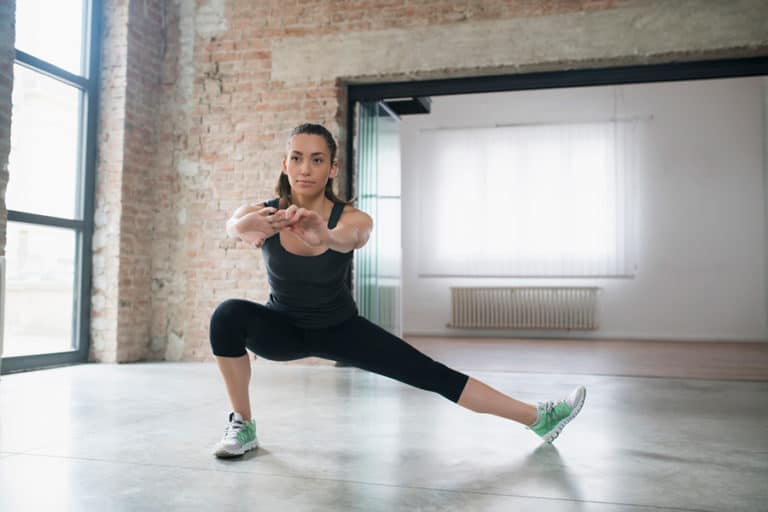Goblet Squat – How To Do, Benefits, And Variations

Kettlebell goblet Squat | Dumbbell Goblet Squat | Muscles Worked | Who should/should not | Add to routine | Safety Tips | Benefits | Variations | Alternatives
The goblet squat is traditionally performed by holding a kettlebell close to your chest. It adopted its name from the movement pattern, which looked similar to holding a big goblet glass with two hands.
This squat is integral to most gym goers’ leg day routine. It is a level above the basic squat exercise.
How to do a goblet squat with a Kettlebell?
If you’re just starting out, here’s how you can perform the kettlebell goblet squat with proper form:
- Assume a shoulder-width stance with your feet pointed slightly outward.
- Hold the kettlebell by the horns with both hands at chest level.
- Keep your elbows close to your sides, core engaged, and torso upright.
- Begin to lower your body by moving the hips down.
- Continue to lower your body until your hips are below your knees.
- Hold the squat position for a moment, drive through your heels and extend your hips and knees to return to the starting position.
How to do a goblet squat with a dumbbell?
You can also try goblet squat with a dumbbell. Here are the steps to follow:
- Stand with your feet slightly wider than your shoulders. Keep your feet pointed slightly outward.
- Hold the dumbbell in the upright position at chest level with both hands.
- Keep your elbows close to your sides, core engaged, and torso upright.
- Begin to lower your body by moving the hips down.
- Continue to lower your body until your hips are below your knees.
- Hold the squat position for a moment, drive through your heels and extend your hips and knees to return to the starting position.
Muscles worked
The goblet squat is fundamentally a compound movement; that is, it works multiple joints and muscles at the same time. For instance:
The primary muscles worked
| Gluteal muscles | gluteus maximus, gluteus minimus, and gluteus medius |
| Quadriceps muscles | vastus lateralis, vastus intermedius, vastus medialis, and rectus femoris |
Secondary muscles activated
| Core | transverse abdominis, rectus abdominis, and the obliques |
| Muscle in the inner thigh | adductor magnus |
| Arms and forearms | biceps and brachialis |
| Upper back | traps, rhomboids, and lats |
Who should and should not do goblet squats?
Goblet squats benefit people of almost all body types with different fitness goals at different fitness levels. Here are some specific categories that should perform goblet squats but with few modifications depending on the workout level:
Beginners
Goblet squat is an intermediate-level to advanced-level exercise. However, it can be easily incorporated by beginners. In fact, it is an exercise that teaches the correct squat form. With lighter weights and fewer reps, beginners can gradually correct their squat form and advance their weight-lifting capacity.
Hypertrophy training
Anyone training for hypertrophy [1]ResearchGate: A Brief Review on the Effects of the Squat Exercise on Lower-Limb Muscle Hypertrophy (muscle growth) in the lower body can benefit from performing squats. Goblet squats employ a long range of motion. This works the quads and glutes intensely, leading to better muscle build in the region.
Fat loss and overall body composition
Goblet squat is an effective compound exercise that works not only the lower body but also a large portion of the upper body.
High-intensity functional training exercises like goblet squats have been observed to have a positive impact on body composition. This makes the goblet squat a great exercise for losing overall body fat. Its results are typically evident when one creates a calorie deficit through dieting.
Athletes
Most sports athletes aim for a leaner body structure over bulked-up muscles. Manipulating the goblet squats with lesser weights and a slow tempo can achieve the goal. Moreover, isometric exercises [2]Mayo Clinic: Are isometric exercises a good way to build strength? help stabilize joints and the core. This proves advantageous for athletes.
Who should not do goblet squats
Anyone with previous injuries or pre-existing medical conditions should perform goblet squats only under the care of a healthcare practitioner.
Adding goblet squats to your routine
Goblet squats can be easily added to your routine with minimal modifications. Here’s how you can do it:
- Beginners may do 3-4 sets of 10-15 reps with light weights to adapt to the exercise.
- Intermediate lifters aiming to improve their endurance can perform about 4-5 sets of 15-20 reps with a weight heavier than that of beginners.
- Advanced lifters aiming for increased muscle size can do approximately 6 sets of 8-10 reps with heavy weights.
If you are new to goblet squats and wish to add them to your circuit, you may try the below-mentioned leg day routine:
- Warm up with 10-15 minutes of cardio (running/cycling)
- Start with a set of kettlebell goblet squats.
- Move to a moderately challenging exercise like a kettlebell sumo deadlift.
- End with a set of kettlebell walking lunges.
- Do 2-3 static stretches [3]Hospital for Special Surgery: Static vs. Dynamic Stretching: What Are They and Which Should You Do? for a cooldown.
Note: Start with a weight that’s challenging but allows you to maintain good form throughout the entire set. The number of sets and reps you do can vary depending on the intensity you are aiming for.
Safety tips
Here are some essential points to consider while performing goblet squats to ensure proper form:
1. Maintain an upright torso position
Maintaining the right posture determines how much weight you can carry. Thus it is best to keep your chest up and shoulders back throughout the entire movement. This will avoid lower back injury, and you will be able to lift weights to your fullest capacity.
2. Knees in line with the toes
Keep your knees in line with your toes as you squat down. Incorrect knee position (falling inwards or outwards) may put unnecessary stress on your knees and can lead to joint injury.
3. Distance of the weight
Holding the weight closer to the chest allows you to maintain the correct goblet squat form, maintain balance, and lift weights to your fullest capacity.
4. Choose appropriate weights
Choose weights that are suitable for your fitness level to gain maximum benefits. Too heavy weights may cause unnecessary pain and difficulty in the range of motion, and light weights may render the exercise ineffective.
5. Use the right technique to push upwards
Only use your heels to drive upwards. One of the common mistakes is to drive up using toes or hips. Doing this wouldn’t target the calves and hamstrings. Instead, it would strain your knees and shin bones.
6. Complete the range of motion
Goblet squats use the deep squat position. To fully engage the major muscle groups, you must squat down until your hips are below your knees.
If you’re having trouble getting low enough, try placing a box underneath you to practice squatting down deep. Keep descending until your glutes tap the box.
Benefits of the goblet squat
Goblet squats are a great lower body exercise. However, they provide several other advantages. Here are some unique goblet squat benefits worth noting:
- Goblet squats strengthen hips and ankles and improve their mobility.
- The kettlebell held in the front of your chest counterbalances your weight and doesn’t strain the back, unlike barbell squats.
- It is an exercise used to learn the correct squat form.
- Goblet squats also work the upper body (upper back, core, and shoulders). Hence it is considered a squat that provides a full-body workout.
Goblet squat variations
To add some change or challenge to your workout, you can include the variations mentioned below:
1. Goblet shooter squat
This goblet squat variation follows the general steps of the basic goblet squats. The moment you have your thighs parallel to the floor, first turn your body to the right from your hips and dip your left knee to the floor. Return to the parallel squat position and repeat it on the other side. Return to the center and drive back with the help of your heels.
2. Pause goblet squat
There is a minute difference in this variation. As the name suggests, all you need to do is pause at the bottom of the squat to feel a good stretch and rise using the correct technique.
Goblet squat alternatives
If you do not have a kettlebell, you may perform the below-mentioned squats instead:
1. Barbell front squat
To do this exercise, place a barbell across your collarbone and your shoulders. Hold it with your hands in an underhand grip. Keep your elbows up as you squat, and make sure that your knees track over your toes as you squat.
2. Sandbag front squat
Using a sandbag for your goblet squat is a great way to add some extra challenge to the exercise. The sandbag will shift as you squat, engaging your stabilizer muscles and forcing you to control the weight.
Conclusion
The goblet squats work the lower body muscles dynamically at the same time. They do significantly well as an upper body workout as well. Add this exercise to your routine to gain maximum benefits by following the steps. Lastly, keep the tips in mind before you start to avoid injury.
References
| ↑1 | ResearchGate: A Brief Review on the Effects of the Squat Exercise on Lower-Limb Muscle Hypertrophy |
|---|---|
| ↑2 | Mayo Clinic: Are isometric exercises a good way to build strength? |
| ↑3 | Hospital for Special Surgery: Static vs. Dynamic Stretching: What Are They and Which Should You Do? |







